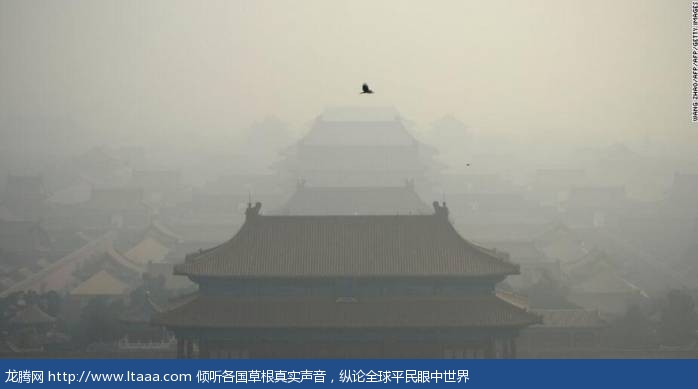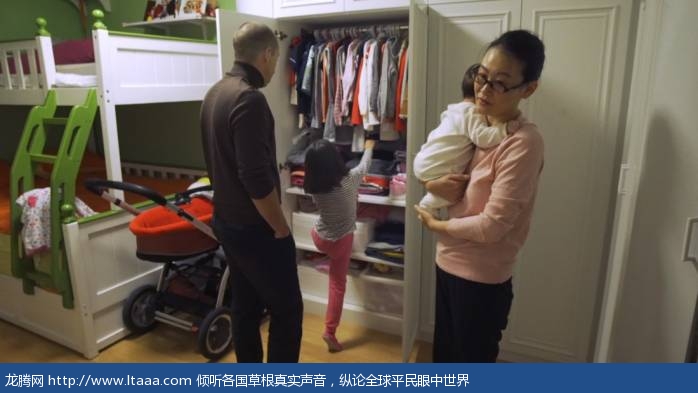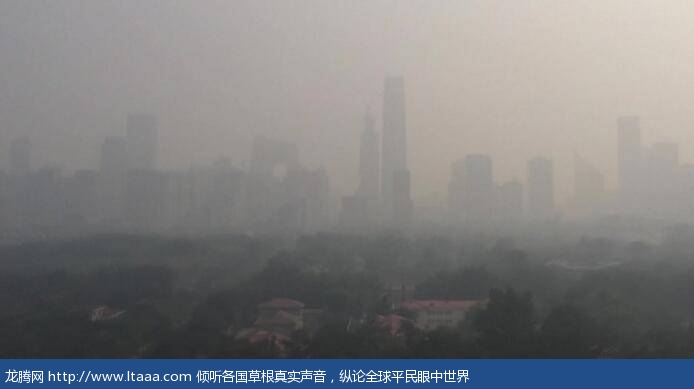【CNN】:北京雾霾下的贫富分化——两种城市,一个故事 [英国媒体]
中国是世界最大的温室气体排放者,且排放代价高昂——据兰德公司数据显示,由于2012年的污染,中国国家经济粗略上损失了5350亿美元。手握新财富,中国上层和中产阶级已能出游海外,见识更大的世界——反之也了解了污染的危险性和避免污染的办法。
Beijing's smog: A tale of two cities
北京雾霾:两种城市,一个故事
The first thing Jiang Wang does when she wakes up in the morning is check on her daughter to make sure she's breathing clean air.
王江每天早上醒来的第一件事就是查看女儿今天能不能呼吸到干净的空气。
Next, it's time to start making breakfast. She's already made sure all the groceries come from an organic farm.
然后该做早饭了。她保证所有的食材都产自有机农场。
She'll wash her produce with tap water filtered through a separate treatment system under her sink.
水槽下方装有分体式处理系统,她用过滤水清洗餐具和食材。
But that water isn't for drinking -- there's imported bottled water for that.
但是过滤水不是用来喝的——喝的是进口瓶装水。
This is how Wang typically starts her day, trying to minimize the effects of the toxic environment in Beijing.
这就是王江一天的开头,尽量把北京有毒环境的影响降到最小。
"From the moment you open your eyes till the moment, you rest in the evening," she says, "you have to pay really (close) attention, to the air, to the water, to the food you eat."
她说:“从早上睁眼到晚上休息,真的要(十分)注意。注意空气,注意水,注意食物。”
Wang and her family are part of a growing number of Beijingers who are trying to pollution-proof their lives.
北京人里像王江和她家其中只是一部分,类似的人数还在持续上涨,他们试图过上和污染隔绝的生活。
And money is no cost.
钱不是问题。
It's "very expensive," she says. "But think about the health. There is nothing to trade off."
王江承认这种生活“特别耗钱”。可转念一想,钱换不来健康。
But for Beijing's rising middle class and poorer residents, this high-end home equipment is financially out of reach.
然而对于北京增长的中产阶级和贫困居民,这种高端家庭器材在收入上就遥不可及。
That's turning pollution into both a health issue and a class issue -- and it's killing off those left behind.
这种差距把一个污染问题转变成了两个,健康问题和阶级问题——且污染正在消灭落在高收入后面的人。
Research by Nanjing University's School of the Environment has linked smog with nearly one-third of all deaths in China, positioning it on a par with smoking as a threat to public health.
据南京大学环境学院调查,中国近三分之一的死亡和雾霾有关。调查认定雾霾对公共卫生的威胁与吸烟同等。
Published in November last year, the study analyzed over 3 million deaths across 74 cities throughout China in 2013. The findings revealed that as many as 31.8% of all recorded deaths could be linked to pollution, with major cities in Hebei, the province that encircles Beijing, ranked among the worst.
去年十月刊登的研究分析了2013年全中国74座城市3百多万死亡案例。结果揭示出全部有记录死亡案例中的31.8%和污染相关,主要分布在河北省。河北省环抱北京,污染排名位列最差之一。
"Air pollution exacerbates inequality between the rich and poor in urban China," Matthew Kahn, a professor of economics at the University of Southern California, told CNN in an email.
南加州大学经济学教授马修·卡恩在邮件中对CNN说:“大气污染加剧了中国城市贫富不均。”
"The rich live in cleaner parts of the city and on more polluted days they can drive to work, work inside, access better doctors, have second homes in the countryside and have expensive and effective air filters."
“富人住在城市更清洁、污染天数更少的地方。他们可以开车去上班,在室内工作,看更好的医生,到乡下多买一处房子,安装昂贵又实用的空气净化器。”
Beijing risks becoming a tale of two cities, a place where the rich and poor don't even breathe the same air.
北京承受着风险,同一个故事中分化成两种城市的风险,变成富人和穷人连呼吸空气都不一样的风险。
It adds up
日积月累
The Wang family recently installed a fresh air filtering system, which cost them about $4,300.
最近王江家花费4300美元安装了一套空气清新过滤系统。
It works like a ventilation system, cleaning outside air and pumping it into their home.
这套系统就像通风系统,净化外部空气再输入室内。
They also have an air purifier in each room, eight in all, to filter out carbon dioxide and take care of any dirty air that may leak in. Those add up to about $7,200.
他们还在每个房间安装了共八台空气净化器,过滤二氧化碳跟任何溜进家里的污染空气。这些器材加起来花了大概7200美元。
And the purifiers need to be changed about once a month -- which rings in at $430.
空气净化器需要每个月更换一次,花费430美元。
Water filters for sinks run about $300 and shower filters can cost upwards of $1,000 on JD, a popular Chinese e-commerce site.
水槽下的过滤器花费大概300美元,淋浴过滤器在京东(中国的一个火爆电商网站)上售价1000美元以上。
For the super wealthy, companies such as Environment Assured, an indoor air quality and water filtration consultancy, will assess the toxicity of living and office spaces.
针对巨富们的需求,环境保障之类的室内空气质量和滤水咨询公司会评定生活环境和办公环境的毒性。
The company offers a top-of-the-line package that comes in at just under $15,000, according to Alex Cukor, the vice president of enterprise solutions at Environment Assured.
据环境保障公司企业方案部门副总亚力克斯·库克表示,公司提供同类商品中最好的产品套装,一套不到15000美元。
Real estate prices can swing based on technology and proximity to pollution, too.
房地产价格会在技术和污染距离远近的基础上摆动。
A two-bedroom apartment in Beijing's MOMA complex -- where the units come equipped with air filtration systems -- cost far in excess of $3 million, according to the Lianjia real estate listings.
根据链家房地产列表数据显示,北京MOMA住宅区里两室一厅的公寓售价远不止3百万,所有单元自带空气过滤系统。
That's almost six times the cost of a similarly-sized apartment on the city's dusty fringes.
这里公寓的售价几近北京灰扑扑的外环同面积公寓的六倍。
And these costs aren't reserved to homes.
而且这些公寓还不面向家庭预售。
The International School of Beijing, where tuition is north of $37,000 a year, built a pressurized dome for kids to play in during the smog. It cost $5 million. (Some public schools have also built domes recently.)
北京国际学校,每年学费37000美元,学校建有加压圆顶体育场供孩子们在雾霾天活动。体育场耗资5百万美元。(一些公立学校不久前也建设了圆顶体育场。)
Some people will get organic produce shipped directly to their homes. A yearly membership to Tony's Farm costs $3,400. That will get you two weekly deliveries of produce, three kilograms (about 6.6 pounds) each.
有机食品会直接运送到部分人家里。托尼农场一年的会员资格收费3400美元,农场每周给每位会员送三公斤(6.6磅)产品。
Others escape the bad air by traveling abroad.
其他人则出游海外以逃离污染空气。
And then there's the more outlandish products.
还有更多稀奇古怪的产品。
You can buy canned air from Britain for $115 a bottle. Anti-pollution creams can top $100 (the jury's still out on how well these work) and there are also expensive "pollution-catching" amulets.
你可以购买产自英国的罐装空气,每瓶115美金。防污染乳霜(审核人员尚未认定产品效果如何)100美元以上。还有昂贵的“污染捕捉”护身符。
The typical Beijinger likely can't afford any of that -- the average individual salary is a little less than $17,00 year, according to a report from Peking University. And that's the highest in China.
从北京大学的数据报告来看,大多数北京人恐怕负担不起其中任何一项——平均个人工资稍低于1700美元。而这个数字在中国是最高的了。
But even though the China's economic boom has delivered material wealth to millions, growing numbers are becoming frustrated that China's elite and ultra-wealthy -- many of whom got rich off the country's rapid industrialization that caused the pollution problem -- can protect themselves, but they can't.
尽管中国经济繁荣为数百万人带来了物质财富,但增长的数字渐渐让精英和巨富垂头丧气——他们中大多数依靠国家高速工业化发迹,而高速工业化带来污染问题,而他们没法从污染中保全自己。
"It really has reached a point where concern over air pollution throughout the country is threatening China's social stability," Barbara Finamore of the Center for Strategic and International Studies (CSIS) said in a question and answer session in May.
战略与国际研究中心(CSIS)的芭芭拉·菲纳莫雷在五月份一次问答会上表示:“对全国大气污染的关注达到了威胁中国社会稳定的节点。”
A recent environmental protest in the southwest city of Chengdu was quickly quashed by authorities.
最近的一次环境抗议发生在西南城市成都,很快就被官方平息了。
Baby steps
婴儿学步
China is the world's largest emitter of greenhouse gasses, and it's costly -- the country's economy lost roughly $535 billion due to pollution in 2012, according to the RAND corporation.
中国是世界最大的温室气体排放者,且排放代价高昂——据兰德公司数据显示,由于2012年的污染,中国国家经济粗略上损失了5350亿美元。
【注】:美国兰德公司,研究政治、军事、经济科技、社会等各方面的综合性智库。世界智囊团的开创者和代言人,最负盛名的决策咨询机构。
The government knows air quality is a pressing problem and publicly declared a "war on pollution" in 2014.
政府清楚空气质量问题迫在眉睫,于2014年公开宣布打响“治污战役”。
With their newfound wealth, China's upper and middles classes have been able to travel abroad and see more of the world -- and in turn learn about the dangers of pollution and how to avoid it.
手握新财富,中国上层和中产阶级已能出游海外,见识更大的世界——反之也了解了污染的危险性和避免污染的办法。
But on the street during a red alert it is still commonplace to see ordinary people wearing a scarf over their mouth and nose, rather than a protective mask. Even state media has said the government needs to better study and understand the effects of pollution.
但污染红色警报期间,街头巷尾照样能见到普罗大众用围巾裹住口鼻而不是戴着防护口罩。尽管官方媒体已经表达了政府需要更好地学习和理解污染带来的影响。
Still, China had some success in recent years, both locally -- 663 localities in Beijing's city limits replaced coal with clean energy, state-run Xinhua news reported -- and internationally, with the signing of the Paris climate accords.
近几年内中国仍取得了一些成绩——地方上,663个北京下属地区限制城市用煤,清洁能源取而代之;国际上,签署了巴黎气候协议。
And China actually leads the world in wind and solar power, according CSIS' Finamore.
战略与国际研究中心表明,实际上是中国引领了世界风能和太阳能的使用。
Such measures though have done little to dispel the view that Beijing is becoming increasingly unlivable. "Under the Dome," a Chinese documentary on the negative effects of pollution, took the country by storm when it debuted in 2015. The film drew millions of views online, before government censors stepped in and removed it from Chinese video sharing websites.
这些措施离对消除北京向不适宜居住逐步变化的作用微乎其微。《苍穹之下》,一部展现污染负面影响的纪录片,2015年首次登场便犹如风暴席卷中国。在政府审查介入并删除视频分享网站上的资源前,影片观影数就达几百万之巨。
A growing industry
工业增长
Where the government sees a problem, entrepreneurs see an opportunity.
A lucrative industry is cropping up around pollution-proofing the lives of people like Wang, who wants to protect her 6-year-old and 3-month old daughters.
政府看到的是问题,企业看到的是机会。
围绕王江那样想保护6岁和3个月大女儿,过上隔绝污染生活的人,一个利润丰厚的产业正欣欣向荣。
"Her (the younger daughter's) life is just beginning and air she breathes in and out is of such bad quality. I couldn't sleep, literally, two nights continuously," Wang said. "Our kids, they are very young. They have life ahead of them."
“她(小女儿)的生命才刚刚开始,她呼吸的空气质量却那么差。想到这个,我连续两晚上都睡不着。我们的孩子还很小。他们还有生活在未来等待。”
Beijing is fertile ground for this new industry -- it's home to more billionaires than any other city in the world.
北京对新兴产业眼中是一方沃土——作为亿万富豪之家,北京胜于世界上任何城市。
There were 200,000 air purifiers sold in China in 2010, according to Daxue Consulting. That number spiked to 2 million four years later. Demand is expected to reach 4 million annually by 2018, according to Huidian Research, a Chinese consulting and marketing firm.
大学咨询公司数据显示,2010年中国售出了20万台空气净化器。四年后这个数字剧增至2百万台。据一家中国咨询和营销机构慧点公司预计,2018年前产品需求将达到每年4百万台。
Much of the current revenue is coming from high-end products, but that is slowly changing.
很多当期收入来自高端产品,但这一情况正慢慢改变。
Air purification is becoming more and more accessible, Cukor says. The Chinese technology company Xiaomi, for example, now offers a relatively potent air purifier for $360.
空气净化器变得越来越普遍。比如中国技术公司小米现在就提供一款相对有效的空气净化器,售价360美元。
Middle-class catch-up
中产追及
But a lot of the spikes in business are fleeting, coming and going with the thick plumes of smog that roll in.
然而许多生意的巅峰不过转瞬即逝,随着涌动的浓稠雾霾来来去去。
Activity at Environment Assured has been nonstop in the past three weeks, since Beijing's most recent "airpocalypse," Cukor says.
自北京最近的“空气末日”,过去三星期里环境保障公司的活动就没停下过。
Data from JD, the Chinese online retailer, shows from December 16 to December 20 -- during the government's most recent red alert pollution warning -- sales of masks on the site increased by 380% while air purifiers, rose by 210%
线上零售商京东的数据显示,从十二月6号到20号——政府最新污染红色警报期间——网站口罩的销售量增长了380%,同期空气净化器增长了210%。
Research from Kahn, the USC professor, found similar trends when analyzing sales data from Taobao, another online retailer, in winter 2013, during another spell of bad air quality.
南加州大学教授卡恩的调查在分析另一线上零售商淘宝2013年一段空气质量恶劣时期的冬季销售数据时发现了类似的趋势。
It's likely because people with less disposable income don't have the time or money to think about prevention until the problem has gotten out of hand.
导致趋势的原因可能是可支配收入较低的人群在问题无法控制之前,既没时间也没金钱来考虑防护措施。
And they're not always buying effective products -- many cheaper options simply don't do the job.
这类人群也没有一直购买有效产品——很多廉价品根本不管用。
Some have called foul on false advertising as well; a recent report in the Financial Times cited claims by concerned mothers who tested the air quality in some malls promising clean filtered air and found it was not as safe as advertised.
有些产品还涉及虚假广告;《金融时报》最新报告引用了忧心忡忡的母亲们的声明,她们测试了部分购物中心承诺其内部空气是过滤的、干净的,却发现空气质量和广告里的并不一样。
"This poor versus rich differential propensity to invest in self protection means that air pollution exposure exacerbates quality of life inequality in Chinese cities because the poor are exposed to more risk," Kahn and the paper's other authors write.
卡恩和其他参与调查的作者写道:“对自我保护投资上的贫富差别化,意味着空气污染加剧了中国城市生活质量的不平等,因为穷人被迫暴露在更高风险下。”
Kahn and and his co-author Zheng Siqi, a professor at Tsinghua University, remain optimistic, pointing to the Kuznets curve.
卡恩与合着作者,清华大学教授郑思齐,指着库兹涅茨曲线对情况保持乐观。
【注】:库兹涅茨曲线,又称倒U曲线。表示收入分配状况随经济发展过程而变化的曲线,是发展经济学中重要的概念
This curve posits that as per-capita income rises, so does environmental degradation -- but only to a point. Once people have enough disposal income that they aren't living day-to-day, they can afford to worry about pollution, counteract it and hold their leaders accountable.
曲线假设伴随人均收入增长,环境退化也同步增长——但仅达到一个顶点。一旦人们的可支配收入足够,那么他们就不会得过且过每一天。人们负担得起对环境污染的担忧,抵消污染并控制领导人的责任。
And when that day comes, pollution should decrease as per-capita income rises.
当那天来临,随着人均收入得到提高,污染也将减少。
For her daughters, Wang hopes that day comes soon.
"For us -- for everybody -- health is number one," she says.
"Without health nothing can be done."
对女儿们,王江希望那一天快些到来。
“对于我们——对于每个人——健康是第一位的。没有健康,什么也做不了。”
版权声明
我们致力于传递世界各地老百姓最真实、最直接、最详尽的对中国的看法
【版权与免责声明】如发现内容存在版权问题,烦请提供相关信息发邮件,
我们将及时沟通与处理。本站内容除非来源注明五毛网,否则均为网友转载,涉及言论、版权与本站无关。
本文仅代表作者观点,不代表本站立场。
本文来自网络,如有侵权及时联系本网站。
图文文章RECOMMEND
热门文章HOT NEWS
-
1
最近,新冠肺炎疫情在日本有扩大的趋势,有专家呼吁日本应当举国行动起来,共...
- 2
- 3
- 4
- 5
- 6
- 7
- 8
- 9
- 10
推荐文章HOT NEWS
-
1
最近,新冠肺炎疫情在日本有扩大的趋势,有专家呼吁日本应当举国行动起来,共...
- 2
- 3
- 4
- 5
- 6
- 7
- 8
- 9
- 10


















